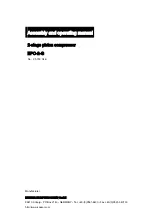
Application Engineering
B U L L E T I N
AE4-1374 R1
protector operation. The controller can lock out the
compressor if current draw is not coincident with the
contactor energizing, implying that the compressor
has shut off on its internal protector. This will prevent
unnecessary compressor cycling on a fault condition
until corrective action can be taken.
Heat Pump Protection
A low pressure control is highly recommended for loss of
charge protection and other system fault conditions that
may result in very low evaporating temperatures. Even
though these compressors have internal discharge
temperature protection, loss of system charge will result
in overheating and recycling of the motor overload
protector. Prolonged operation in this manner could
result in oil pump out and eventual bearing failure.
A cut out setting no lower than 10 psig (0.7 bar) is
recommended.
Operation near -25°F (-32°C) saturated suction
temperature is clearly outside the approved operating
envelope shown in Figure 7. However, heat pumps
in some geographical areas have to operate in this
range because of the low ambient temperatures. This
is acceptable as long as the condensing temperature
is not above 90°F (32°C) and the resulting discharge
temperature is below 275°F (135°C). Some liquid
floodback to the compressor under these conditions
can help keep the discharge temperature under control.
Discharge Line Thermostat
Some systems, such as air-to-air heat pumps, may not
work with the above low pressure control arrangement.
A discharge line thermostat set to shut the compressor
off before the discharge temperature exceeds 260°F
(125°C) may have to be used in conjunction with a low
pressure control installed in the liquid line to achieve
the same protection. Mount the discharge thermostat
as close as possible to the compressor discharge fitting
and insulate well. See Figure 5 for recommended
Emerson Climate Technologies part numbers.
Air Conditioning Unit Protection
Air-conditioning-only units can be protected against
high discharge temperatures through a low pressure
control in the suction line. Testing has shown that a
cut out setting of not lower than 25 psig (1.7 bar) will
adequately protect the compressor against overheating
from the aforementioned loss of charge, blower failure
in a TXV system, etc. A higher level of protection is
achieved if the low pressure control is set to cut out
around 55 psig (3.8 bar) to prevent evaporator coil icing.
The cut in setting can be as high as 105 psig (7.2 bar) to
prevent rapid recycling in case of refrigerant loss. If an
© 2013 Emerson Climate Technologies, Inc.
Printed in the U.S.A.
electronic controller is used, the system can be locked
out after repeated low pressure trips.
High Pressure Control
If a high pressure control is used with these compressors
the recommended maximum cut out setting is 425
psig (30 bar). The high pressure control should have
a manual reset feature for the highest level of
system protection. It is not recommended to use the
compressor to test the high pressure switch function
during the assembly line test.
Shut Down Device
The new ZR*K5 scrolls incorporate a scroll discharge
port check valve that prevents high pressure gas
trapped in the dome from returning through the scroll set
after shutdown. The shutdown device allows the scroll
compressor to restart immediately even if the system
is not equalized, eliminating the need for a time delay.
Development testing should include a review of the
shutdown sound for acceptability in a particular system.
Please refer to the section on
“Brief Power Interruption”.
Discharge Check Valve
A low mass, disk-type check valve in the discharge fitting
of the compressor prevents the high side, high pressure
discharge gas from flowing rapidly back through the
compressor after shutdown. This check valve was not
designed to be used with recycling pump down because it
is not entirely leak-proof.
Motor Overload Protection
Conventional internal line breakmotor overload protection
is provided. The overload protector opens the common
connection of a single-phase motor and the center of
the Y connection on three-phase motors. The three-
phase overload protector provides primary single-phase
protection. Both types of overload protectors react to
current and motor winding temperature.
Operating Envelope
NOTICE
It is essential that the glide of R-407C is carefully
considered when adjusting pressure and
superheat controls.
The ZR*K5 compressors are approved for use with R-22
only. The ZR*K5E compressors are approved for use
with R-22 and R-407C. See Figure 7 for the R-22 and
R-407C operating envelope. The envelope represents
safe operating conditions with 20F° (11K) superheat in
the return gas. Use of refrigerants other than R-22 or
R-407C voids the UL listing of these compressor models
5






































